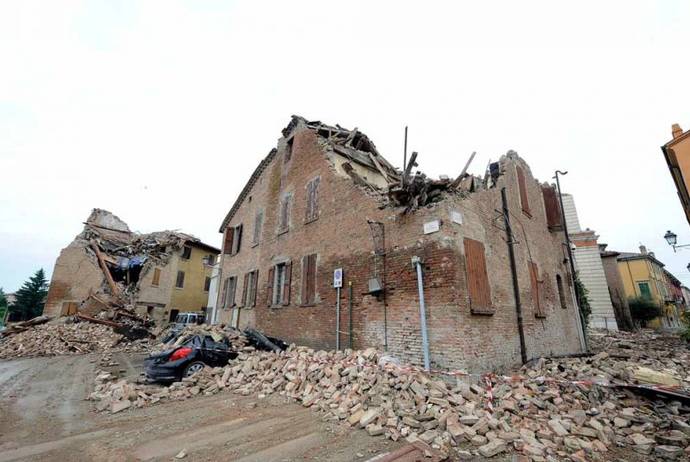The recent earthquakes that have hit Emilia Romagna have caused deaths, forced the population out of their homes, damaged businesses and destroyed many other important infrastructures in the region.
In times of need, Italy can rely on the support of its sons around the world, and the American sons of Italy are surely among the most active in providing immediate response when natural catastrophes and other disasters occur.
When the L’Aquila earthquake occurred in 2009, the National Italian American Foundation was able to raise over $800,000 and to contribute over $250,000 to the building of a new earthquake-resistant modular student center at the University of L’Aquila, completed over the Summer of 2011.
The Emilia Romagna earthquakes motivated NIAF to embark on a very innovative relief project that goes by the name of “Italian American Relief.” The initiative is online-based, and wants to facilitate the creation of a support network through its website, which will also be used for other fundraising campaigns in the future.
John Viola, Chief Operating Officer of NIAF, told i-Italy in an exclusive interview about IAR: “When the Emilia Romagna earthquake happened we realized that raising funds might have been more difficult than in 2009. The effects of the quake were different, a lot of businesses were affected, numbers were different. We knew we needed a different strategy to fundraise.”
That’s why NIAF decided to open a solidarity portal on the internet, for all the Italian-American groups to unite their efforts in one place, and with a formula that serves a broader scope than the current emergency: “I think it’s important as a national organization and as an Italian-American community that we are the frontline for any kind of reactive relief that has to happen in Italy, but instead of finding ways to help when disastrous events occur, we wanted to always be on the lookout for an opportunity to help, not just through NIAF, but with every other Italian-American organization we can involve,” Viola told i-Italy.
“We can be so much stronger proactively.”
The current campaign on IAR’s website has been running from June and will continue until September 2012. The established goal is to raise $ 250,000 for an educational and rehabilitation center for children with grave disabilities, Cooperativa Sociale Nazareno, located in the Villa Chierici of Santa Croce di Carpi, Modena.
The Cooperativa is the home to 27 children and looks over nearly 200 other children in the area. The roof of the Cooperativa was severely damaged in the earthquake, making the building unsafe for the children that normally use the facilities inside.
Viola recently flew to Italy to visit the Cooperativa Sociale Nazareno, and elaborated for i-Italy on how NIAF decided to select the Cooperativa among other causes worth being supported for the launch of IAR.
“We wanted to adopt one distinct cause that may not get direct help from government agencies or other organizations. Something very direct, where the money goes 100% from our donors to the project we decided to support. We reached out to our sister organizations in Italy to try to find groups that had a clear cut project and already knew what needed to be done, groups with a framework in place that just needed the money to proceed.”
That’s how a choice was made on Cooperativa Sociale Nazareno : “It gave us a possibility to fix something broken, not just to sponsor something without any results. We were first of all personally moved by the work they do there and by their mission. Not only do they educate and do physical therapy for these children, but they also teach them to create artisanal products that are then sold.”
Cooperativa Sociale Nazareno creates industry and increases the quality of life for the children it looks over, something that NIAF is particularly sensitive to: “That’s the reason why we offer scholarships and grants, that’s what we are committed to as an organization,” Viola adds. “The sooner we can help the Cooperativa get back on its feet, the better it will be for us and for everybody.”
Besides the intrinsic value of the cause it is backing, the concept behind IAR is very interesting as far as the networking side of it is concerned.
When the Italian-American community is organized in a galaxy of bigger and smaller groups and organizations, it is significant that the biggest of them, NIAF, is taking the initiative to build bridges: “This is not about putting our name on it or giving visibility to a brand. Support and relief has to come from the Italian-American community as a whole.”
Networking, in Viola’s opinion, is to be meant in the most altruistic sense: “It’s about magnifying the contribution that people of Italian ancestry can make all over the world. We can accomplish so much more if we do it together as a globalized ‘populus’ defined by the italianità that bonds us.”
This participatory approach will also be determinant for Italy’s future in the globalized world, especially when the younger Italians are losing their faith in seeing their homeland change for the better, and when many of them actually try to move to different countries to build a better future – USA on top of the destinations’ list.
As the youngest Chief Officer in the history of NIAF, 28-year old Viola says that “for a two-trillion dollar economy to devolve into a nation that exports people and talents is problematic.”
The problem, however, is broader: “It alarms me to see that the backbone of Italy’s economy, the family firms that produce great and technologically advanced products, are having problems creating startup capital and ending up going for foreign investment, selling or closing. How many opportunities is Italy missing?”
And since on the other side of the pond, the American investment in Italy “is lower than it is in Lichtenstein,” Viola tells i-Italy that the role of Italian-Americans “is to figure out what barriers there are, how to create better business opportunities. I think that as a component part of Italy, we Italian-Americans should be drawing investments and figuring out how to encourage them.”
“As Italy changes and the world does too,” says Viola, “let’s use to Italy’s advantage the fact that Italy has sent out over 140 million descendents from its soil to the rest of the world, and we have accomplished things, built lives and businesses, and we still feel somehow Italian. Why should we not be included to its benefit?”
The phenomenal thing is that these Italians from America are actually already finding their own strategies to be closer to Italy, in innovative and productive ways such as the Italian American Relief initiative promises to be.






































